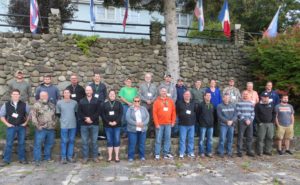 The first of three sessions was held for Wisconsin’s Community Tree Management Institute (CTMI). Twenty-six students from across the state met in Green Lake, WI October 17-18. These municipal tree managers (who lack technical and program management in arboriculture) learned the foundations of urban forestry. Through hands-on training and exercises, students learned about: canopy and measurement tools, tree benefits, awareness and support, politics and policy, leadership, partnerships, legal issues, ordinances, budgeting, tree boards and utilities. Instructors for session I included: municipal foresters, public works directors, a UW Extension agent, utility representatives, consultants and DNR staff. The variety of instructors, their perspectives and interactive components is meant to appeal to all learning styles. Continue reading “Community Tree Management Institute was a success”
The first of three sessions was held for Wisconsin’s Community Tree Management Institute (CTMI). Twenty-six students from across the state met in Green Lake, WI October 17-18. These municipal tree managers (who lack technical and program management in arboriculture) learned the foundations of urban forestry. Through hands-on training and exercises, students learned about: canopy and measurement tools, tree benefits, awareness and support, politics and policy, leadership, partnerships, legal issues, ordinances, budgeting, tree boards and utilities. Instructors for session I included: municipal foresters, public works directors, a UW Extension agent, utility representatives, consultants and DNR staff. The variety of instructors, their perspectives and interactive components is meant to appeal to all learning styles. Continue reading “Community Tree Management Institute was a success”
Making room for sustainable sourcing
By Dwayne Sperber, owner, Wudeward Urban Forest Products and appointed member, Wisconsin Urban Forestry Council
When a company has publicly committed to corporate social responsibility, environmental conservation, or working with and through the local community, a new construction project is the time to put these philosophies into action. Unfortunately, this is easier said than done.
Designs may get drawn up with the best sustainably-minded intentions — locally-sourced, low emissions, recycled, reused, energy efficient, the list goes on. But as familiar as the design and construction industries are with using environmentally-friendly materials, most of these products do not come in standard sizes, colors or volumes. And they don’t always fit seamlessly into a standard construction management process. Continue reading “Making room for sustainable sourcing”
Wisconsin Urban Forestry Council meeting
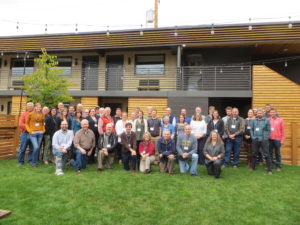 The Urban Forestry Council held their most recent quarterly meeting on October 13 at The Oxbow Hotel in Eau Claire. This was the second time the Wisconsin Council met with their colleagues in Minnesota, board members from the Minnesota Shade Tree Advisory Committee and MN DNR urban forestry staff. In addition, they were joined by Urban Forestry Council members from several additional states: Indiana, Iowa, and Michigan. The Wisconsin Urban Forestry Council and Wisconsin DNR were pleased to welcome these urban forestry representatives from the region for the meeting. Continue reading “Wisconsin Urban Forestry Council meeting”
The Urban Forestry Council held their most recent quarterly meeting on October 13 at The Oxbow Hotel in Eau Claire. This was the second time the Wisconsin Council met with their colleagues in Minnesota, board members from the Minnesota Shade Tree Advisory Committee and MN DNR urban forestry staff. In addition, they were joined by Urban Forestry Council members from several additional states: Indiana, Iowa, and Michigan. The Wisconsin Urban Forestry Council and Wisconsin DNR were pleased to welcome these urban forestry representatives from the region for the meeting. Continue reading “Wisconsin Urban Forestry Council meeting”
Healthcare facilities using green spaces to help in healing
Imagine taking a relaxing walk in a wooded area, listening to the sounds of wind through trees, birds, and water running down a stream and seeing beautiful, vibrant shade of green. This type of an environment has shown numerous benefits, from cleaner air and water to increased health benefits like reduced stress and blood pressure. Continue reading “Healthcare facilities using green spaces to help in healing”
Forest products celebrated
Forestry organizations, businesses, and communities celebrated Wisconsin’s diverse forest products sector during National Forest Products Week on October 15-21, 2017. Gov. Scott Walker also proclaimed the week as Forest Products Week in Wisconsin, encouraging citizens to recognize the many products that come from our forests because of the people and businesses that work in and care for forests. Several forest products businesses and organizations hosted open house events throughout the week. DNR produced a new handout to showcase the economic value of Wisconsin forests. If you’d like copies of this printed publication, send an email to DNRFRPublications@wisconsin.gov noting your street address, the number of copies you’d like and the publication code number (FR-698). Continue reading “Forest products celebrated”
Architecture students use Wisconsin’s underutilized wood species as mass timber
Over the summer, Forest Products Specialist Scott Lyon had the opportunity to provide technical assistance in sourcing wood materials and product development for a summer immersion program at the School of Architecture at Taliesin in Spring Green. The immersion program is geared to college-level participants and adults interested in deepening their understanding of the architectural discipline, this experience provides an opportunity to learn about architecture side-by-side with faculty and students at the Frank Lloyd Wright School of Architecture. Continue reading “Architecture students use Wisconsin’s underutilized wood species as mass timber”
Wood construction seminar was a success
On September 20 , 2017, the Forest Products Services Program, in partnership with Forest Stewards Guild, American Institute of Architects, Structural Engineers Association, and the Wisconsin Wood Marketing Team (USDA Forest Service), organized and hosted an educational seminar titled, “Wood-Based Construction – Mass Timber and Beyond.”
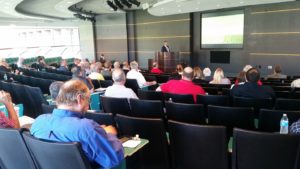 Approximately seventy people attended the event including architects, structural and civil engineers, forest products industry representatives, and researchers. Architects and engineers were targeted for this seminar due to their role in planning, designing, reviewing construction projects, and using of building materials (e.g. wood and mass timber products).
Approximately seventy people attended the event including architects, structural and civil engineers, forest products industry representatives, and researchers. Architects and engineers were targeted for this seminar due to their role in planning, designing, reviewing construction projects, and using of building materials (e.g. wood and mass timber products).
Forest products news and events
- Grant Opportunity: US Forest Service to award $7 million in grant applications for projects that expand wood products and wood energy markets. Find details here.
- Hoppe’s Urban Wood Lab Store takes a sustainable and local approach to lumber and wood products by partnering with Brown Deer High School to utilize urban wood. Read more here.
- Lake States Lumber Association, 2018 Winter Meeting, January 17-19, 2018, Paper Valley Hotel in Appleton; Registration information here.
- Wisconsin Local-Use Dimension Lumber Grading Workshop on February 27, 2018 at the DNR Service Center in Rhinelander.
- Thermally-modified wood (TMW) produces sustainable value-added wood products with extended service-life, and reduced environmental impacts. Read more about this product and professional consumer perceptions about Thermally-Modified Wood.
Six new counties quarantined for EAB
Since the August newsletter, it was announced that six new counties would be quarantined for emerald ash borer (EAB). The find in Chippewa County was due to a vigilant landowner while the other finds were due to trapping by USDA APHIS.
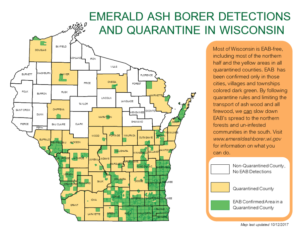
WI counties quarantined for EAB (DATCP). Most of Wisconsin is EAB-free, including most of the northern half and the yellow areas in all
quarantined counties. EAB has been confirmed only in those cities, villages and townships
colored dark green.
Look for next year’s gypsy moth infestations
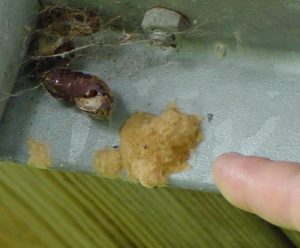
Gypsy moth egg mass
Early fall is the best time for property owners to determine whether gypsy moths will be a problem next year. Gypsy moth egg masses are tan-colored and about the size of a nickel or quarter. Egg masses will not hatch until next spring, which means landowners have plenty of time to plan to minimize gypsy moth damage next summer. New egg masses produced this year feel hard, whereas those that are older are soft and appear faded. Most egg masses will be found on tree trunks and the undersides of branches, but they can also be found on buildings, firewood piles, vehicles and other outdoor objects.
Continue reading “Look for next year’s gypsy moth infestations”
